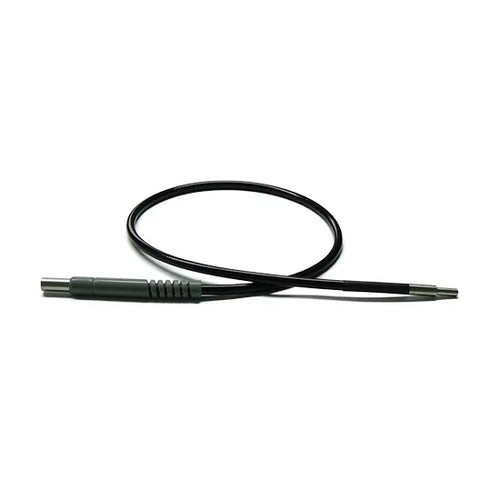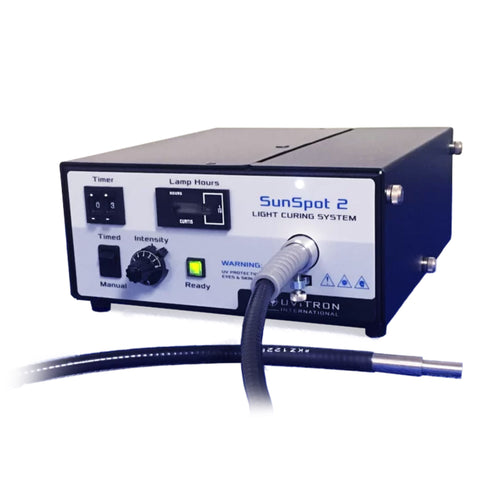February 2, 2025
Sometimes UV curing requires precision. UV spot systems use concentrated beams of light to cure small areas at a time. These systems will often involve the use of either a liquid-filled light guide or a quartz-fiber optic light guide to transmit the light to the precise application area.
In this article, our team of dispensing experts will review the differences between liquid light guides and fiber optic light guides to help you decide which one is the best match for your needs.
What are Fiber Optic Light Guides?
Fiber optic light guides or sometimes called fiber bundle light guides are made from fused silica material fibers bundled together. They are the original technology used to transmit light in spot systems to the target area(s). Fiber optic light guides may have only one or several poles depending on whether or not there are multiple cure targets. They also come in different lengths and with different diameters for different applications.
Fiber light guides tend to be rigid. They have long lifespans and low rates of performance decay when taken care of correctly.
What are Liquid Light Guides?
Liquid light guides are a newer type of UV light guide with a saline solution core. They effectively transmit light along the sealed tube from the source to the target area(s). They come in different diameters and lengths. They can also have a different number of poles to meet various application needs.
Liquid light guides are known for their high intensity of transmitted energy and great flexibility as they can bend and twist easily without being damaged. Liquid light guides also often tend to be less expensive than fiber optic light guides, but liquid light guides require regular cleaning to work effectively.
The Differences Between Liquid Light Guides and Fiber Optic Light Guides
While liquid light guides and fiber optic light guides are both used in UV spot systems to transmit light to specific, precise areas, there are some notable distinctions between the two. Our team is taking a closer look at the differences between liquid light guides and fiber optic light guides.
Flexibility
Because of their liquid core, liquid light guides tend to be much more flexible than fiber quartz light guides. While fiber optic light guides may have a minimum bend radius, liquid light guides are able to bend and twist much more freely without being damaged. This flexibility is great for applications where the positioning of the light guide involves a tight or complex space.
Light Transmission Efficiency
Compared to fiber optic light guides, liquid light guides generally offer higher light transmission efficiency, especially in single-pole systems. Fiber optic guides have a lower numerical aperture that captures less energy from wide emitting angles and that leads to a lower intensity of transmitted energy. That being said, liquid light guides do require active balancing in multi-pole configurations to ensure uniform energy distribution across all poles.
Durability and Lifespan
When considering the differences between liquid light guides and fiber optic light guides, it is important to look at the environment. Liquid light guides can degrade over time, especially with regular, high-intensity UV light exposure. They are also more sensitive to high temperatures than fiber optic light guides, so prolonged exposure can lead to reduced efficiency and faster degradation. As a result, liquid light guides may have a shorter lifespan and need to be replaced more often.
Cost
In general, liquid light guides tend to be less expensive than fiber optic light guides. That being said, liquid light guides may need to be replaced more often if used in harsher conditions.
Liquid Light Guide or Fiber Optic Light Guide?
When choosing between a liquid light guide and a fiber optic light guide, it is important to consider the specific application. How much space is available? Do you require flexibility? Will the light guide be exposed to high heat? How important is light transmission efficiency? What is your budget?
The answers to these questions can help you determine whether a fiber optic light guide or a liquid light guide is the best choice for you. If you are still unsure, we want to help. Contact us to speak with a dispensing expert and get a personalized product recommendation. We carry a wide selection of UV light guides and can point you in the right direction.











